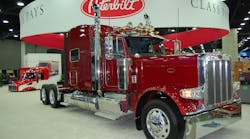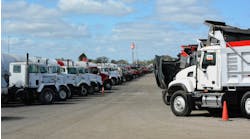LOUISVILLE. Truck manufacturers and component suppliers alike believe truck sales for heavy- and medium-duty units alike should strengthen in the coming years as underlying economic fundamentals continue to strengthen and carriers win freight rate increases that should enable them to purchase new equipment.
"We're expecting a big year for 2014 for the entire industry as the positive trends [that arose] in 2013 are continuing into this year," noted Robert Woodall, director of sales & marketing for Peterbilt Motors Co., during a press event here at the 2014 Mid America Trucking Show.
Woodall explained that the OEM's “positive outlook” is supported by economic indicators as well as evidence that fleets are reporting strong financials; that freight volumes are rising and that markets reliant on vocational trucks are seeing increased activity.
He said that those upward – and lasting – trends are "leading fleets to decide to replace more older equipment and to add capacity" this year.
The upshot, according to Woodall, is that Peterbilt is projecting Class 8 sales of up to 240,000 units in 2014 "due to both replacement demand and adding capacity."
He added that 2014 medium-duty sales should reach 75,000 units, which would amount to "a modest year-over-year improvement" for the segment.
“We’re definitely encouraged by the first quarter order numbers so far,” added David Hames, GM of marketing and strategy for Daimler Trucks North America (DTNA), in an interview with Fleet Owner. “Though we still expect to experience a typical ‘summer slump’ in the second and third quarter, we’re finally starting to see some of the underlying economics line up.”
Hames stressed, though, that this “surge” in orders is coming now mainly from small to mid-sized carriers, as most of the big fleets have already replaced older equipment.
“We’re experiencing a weird dichotomy in that once the big fleets witnessed the reliability and fuel efficiency potential of post-2010 trucks, they went out and bought them while the smaller and medium sized fleets did not,” he explained. “But now the smaller guys are in the market, trying to get equipment, though they will need to work through some sticker shock if they haven’t bought trucks since 2007.”
Göran Nyberg, president of North American sales & marketing for Volvo Trucks, is projecting a roughly 250,000 Class 8 unit market for 2014. “The economic indicators are quite good and the average age of Class 8 units in the U.S. is around 8 years, which tells me there is pent-up demand for replacement equipment,” he said. “Therefore I believe 2014 will be a good year.”
Nyberg added that much of the Class 8 demand Volvo is experiencing in the U.S. market right now is coming from regional fleets. “That segment of the market is growing,” he noted. “We even see some owner-operators getting back into the market; another reason why we see the [Class 8] market expanding this year.”
Stephen Roy, newly-installed president of North American sales & marketing at Mack Trucks, also believes the Class 8 market is poised for strong sales this year and predicts they should top 250,000 units in 2014 – a return to 2012 levels, when sales reached 249,000 units, after a drop-off last year to 236,000 units.
“We expect modest U.S. GDP [gross domestic product] growth of 2.7%, with rising consumer spending, business investment and imports to be good trends for freight demand,” he said. “Construction will remain an important driver of the economy, with housing growing 20%, while replacement demand will drive truck sales.”
Roy expects the regional and vocational truck markets to be strong in 2014 – “That’s right in our sweet spot,” he emphasized – with demand for long-haul Class 8 sleepers to be “up a little.”
Gary Moore, GM for Kenworth Truck Co., is projecting that retail Class 8 sales should range between 210,000 and 240,000 units this year – making 2014 potentially the third largest Class 8 truck sales market in the industry’s history – with medium-duty sales expected to range between 65,000 and 70,000 units.
“Freight tonnage is at an all-time high, plus housing starts have increased 17% and auto production is up 7% this year, which helps drive sales of both on-highway and vocational trucks,” he said. “The key to this year is continued economic growth and trends are favorable; GDP [gross domestic product] growth was 3.2% in the fourth quarter and consumer confidence is rising.”
Bill Kozek, president of trucks and parts for Navistar Inc., projected Class 8 demand to range between 220,000 and 230,000 units in 2014, with what he described as “a lot of order intake” over the last four months fueling the OEM’s positive outlook on sales.
“The order volume of 105,000 units we’ve seen from November last year through February this year actually equates to an overall market for 315,000 units in 2014, but I just don’t think that is in the cards,” he told Fleet Owner. “The medium-duty side of the market is coming back at a much faster rate than the Class 8 side and we expect to see 65,000 to 70,000 units in that segment this year.”
Joe McAleese, president and CEO of Bendix Commercial Vehicle Systems, is projecting a 15% increase in Class 8 sales year followed by a further 5% to 15% sales jump in 2015 based on the economic fundamentals he’s following.
Consumers drive about 70% of our economy, so as long as consumer confidence is strong, the economy is going to grow,” he said. “Right now we’re looking at GDP growth of 2.5% to 3% this year, which isn’t bad but isn’t great either.”
Pat D’Eramo, president of the commercial vehicle technologies business at Dana, added that he believes the industry “should see a little bit of an uptick” in truck sales this year or perhaps 2% to 3% based on current trends.
John Coll, VP-global marketing for Eaton, is forecasting a Class 8 market of 265,000 units for 2014, though Eaton is “keeping an eye” on March order rates as the numbers have trended upwards from December 2013 through January and February this year.
John Larkin, managing director and head of transportation capital markets research for Wall Street firm Stifel, Nicolaus & Co., added in a research report issued this week following the recent Truckload Carriers Assn. meeting in Grapevine, TX, that the U.S. economy is continuing to grow slowly and steadily though he sees “little reason” for the annual rate of economic growth to accelerate much beyond 2% to 2.5%.
“Many carriers spoke of 3% to 8% rate increases as the first quarter and how weather-driven supply chain havoc has caused many shippers to cave on rates,” he added. “It will be interesting to see if the rates hold up once the snow and ice melt and once the spring and summer merchandise stocking period is behind us. Will the third quarter demand once again prove disappointing once properly sized inventories are finally sitting in the right places across the U.S.? With tepid demand continuing, inventory replenishing may well be easily covered by existing capacity.”
In Stifel’s view, 2014 will be a good, solid year for carriers but not the year that marks the start of "the mother of all capacity shortages."
“We are approaching the time when asset owners will hold the cards in negotiations with shippers and brokers; the cavalcade of forthcoming federally mandated safety rules and regulations will ensure that,” Larkin stressed.
“Most new trucks entering the industry are for replacement of existing equipment, with carriers inclined to accelerate their replacement cycles as the cost of capital is now low and fuel efficiency can be 10% to 15% better with the new equipment relative to the equipment it replaces,” he pointed out. “Plus, the used truck market remains robust, providing further incentive for carriers to speed up the trade cycles.”



